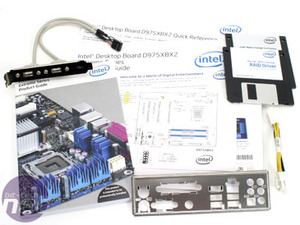Intel Desktop Board D975XBX2
Price (as reviewed): £149.48 (inc VAT)Latest UK Pricing
Latest US Pricing
Intel's 975X Express chipset has been around since November 2005 (that's two thousand and five - Ed.), so you're probably wondering why we're not only revisiting an old chipset, but also a 'reference' board, too. When Intel launched its Core 2 Duo processors, the company naturally became 'trendy' with the enthusiast crowd again after being out of favour for quite some time thanks to AMD's long standing Athlon 64 architecture. Thus, the chip giant wanted to tap into the overclocking / gaming money pit that is becoming increasingly important to tech companies.
The 975X chipset has quite a wide range of usage patterns, as Intel markets the chipset as both a performance desktop and a workstation chipset. Reliability and robustness are both key to the two different usage models in completely different ways and we're assuming that's why the company has two different boards for the two different applications.
Today, we have a look at the performance / desktop version of the board, coined the D975XBX2, to find out if it's any good. It's the second iteration of the Bad Axe, and is more enthusiast friendly than the first edition. The initial Bad Axe board didn't support Core 2, but support was bolted on after revision 304; the reason for this was because Core 2 required a change in the way the board handled power regulation.
Intel D975XBX2 Overview
- Support for all Intel LGA775 processors, including Pentium 4, Pentium D, Pentium Extreme Edition, Core 2 Duo, Core 2 Quad and Core 2 Extreme;
- Intel 975X (82975X) and ICH7DH (82801GH) chipset;
- Support for up to 8GB of DDR2-533, DDR2-667 or DDR2-800MHz memory;
- Three PCI-Express x16 slots for CrossFire (top two running either x16 and x1, or x8 and x8, and third slot locked to x4);
- Two PCI slots;
- SigmaTel STAC9274D High-Definition Audio codec with 8 channel audio, jack sensing, and S/PDIF;
- Intel 82573L Gigabit Ethernet LAN Controller;
- Four native SATA 3Gbps ports supporting RAID 0, 1, 0+1, 5 and JBOD with Intel Matrix Storage;
- Marvell 88SE61XX RAID controller with four SATA ports (eSATA support on the red SATA plus).
- Support for eight USB 2.0 ports (four on rear I/O panel, four via on-board pins/expansion brackets);
- Two IEEE1394a Firewire ports (one on rear I/O panel, one via on-board pins/expansion brackets);
- One ATA133 connector and one floppy connector.
Bundle


The IDE cable is of normal length, and the SATA are even slightly on the long side. Intel include a Marvell controller as well as the on-board ICH7R SATA ports, so if you want to use the Marvell controller as well as the on-board SATA you have to provide your own cables as only four are included.


No extra Firewire PCI brackets are included, and there are only two extra USB ports. The southbridge supports a total of eight USB 2.0, and given the rear I/O only supplies four you’re left with an extra two that will probably be used at the front of the case. The whole package is heavily weighed under the assumption that a standard ATX case will be used.

MSI MPG Velox 100R Chassis Review
October 14 2021 | 15:04






Want to comment? Please log in.